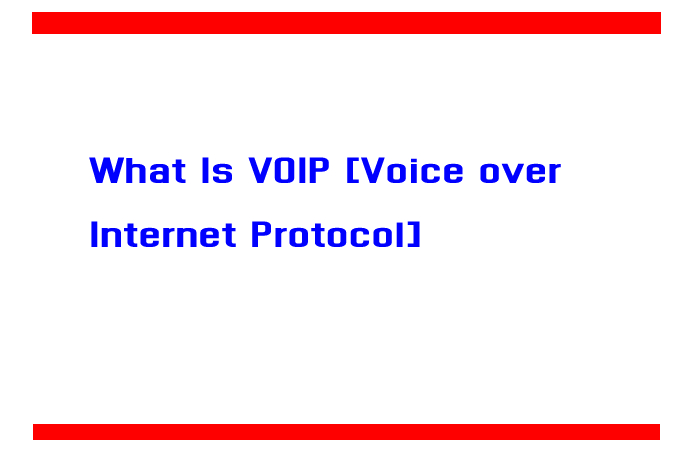Introduction
VOIP opinions to Voice Over Internet Protocol is a method you can make voice calls on the Internet. The audio of what you are saying in the microphone is taken and converted into digital data, transmitted over the network device, and interpreted to hear the voice again.

It is an alternative to conventional phone calls. With VOIP, you do not rest on the antennas or the telephone cable signal but rather on the Internet coverage. You have to be able to transmit the calls.
Voice over Internet Protocol (VOIP) is a technology that allows you to make voice calls using a data network instead of a similar phone line.
VOIP Voice Over Internet Protocol solutions are hosted online and can access through an application installed on a computer or mobile device related to the Internet.
VOIP explanations do not require additional equipment or costs, so your business can jump using telephone assistance in minutes.
How VOIP [Voice over Internet Protocol] Technology Works
Contextualizing VOIP technology
VOIP Voice Over Internet Protocol phone systems work entirely differently than the traditional analog systems we have used for the last few decades.
A cable supports analog systems with two fine copper wires that transmit an electrical signal that, in turn, is transform into sound waves. For example, When we talk on the phone, these waves are responsible for sending the voice.
The analog system allows only one communication for each contract line, which favors its use in the residential market. Each of these lines is registered under an identifier number or geographic DDI.
In Addition To Referent Lines, VOIP [Voice over Internet Protocol]
digital lines are generally use because the digital system allows various communications to be transmitted digitally (singles and zeros).
This transmission can also chance done by traditional telephone chains. Its operation is inserted within the United Services Digital Network (ISDN or ISDN in English).
The basis of this system is a digital protocol that can provide a broad spectrum of services, both voice and teleservices, and others.
In this system, the ISDN lines allow 30 simultaneous communications through 30 channels of 64 Kbps, either for voice or data. In addition, each channel supposes a numbering (DDI) that is use to call and receive calls.
Digital calls are generally free of noise and interference, so their sound quality is superior to analog calls. However, a negative aspect is that the number of simultaneous communications is limit.
Characteristics Of VOIP [Voice over Internet Protocol] Technology
For its part, VOIP does not need separate infrastructure or telephone lines but works on a pre-existing framework, which is the same one use to provide Internet to a large part of the world.
Essentially. An IP line is nothing more than a voice channel in which the call is transmit over the Internet network by connecting a SIP device or a PBX with the VOIP worker.
The SIP regular is the most use for VOIP calls, and the number of channels existing to be use is train only by the bandwidth offer by our VOIP telephony worker.
It is important to message that there are no physical IP telephone lines. Instead, VOIP technology is support by data connections (fiber optics, ADSL, LAN…). It is from these connections that demands are made.
Less We Will Mention Some Characteristics That Can Help Us Understand What IP Telephony Is, What VOIP Is, And Why This Technology Is Fast More And More Received In The Business Market:
- IP telephony does not use physical shapes but connects to the Internet network.
- Unlike similarity and digital lines, VOIP has no preset limits on the number of real-time conversations.
- VOIP Voice Over Internet Protocol technology allows hosting phone numbers in the cloud of the telecommunications operator.
- With VOIP, it is likely to create a network uniting multiple locations, facilitating the interconnectedness of distant physical spaces under a single goal number.
- The situation allows computers to make calls without linking them with telephone sets.
- It is possible to make high-quality calls in correspondence with the quality of the Internet and the company’s technological resources.
Examples Of VOIP Voice over Internet Protocol Applications
Skype
Skype is a representative example of It is a viral application that has a large number of clients. Therefore, it is natural to use and be well-suit with Microsoft and Facebook accounts.
This winner of VOIP technology allows us to make audio and video calls online. Moreover, it sends complimentary instant messages to Skype users worldwide. It is cross-platform.
Viber
Although not so much in America, Viber is a complete VOIP application trendy globally. Allow your customers to type free, high-quality calls and video calls. It is also cross-platform.
Utilizing Viber, you can also chat and send all types of files. According to statements by Talmon Marco, creation CEO of Viber, the platform has a database of 200 million active users. So popular.
Facebook Messenger
Although the statement is exaggerate, we cannot deny the tremendous weight of the blue giant in the networks. Its VOIP application, Messenger, is viral.
Messenger allows its customers to make free audio and video VOIP calls and send instant messages. It also works as an SMS manager, making it a versatile app.
Also Read: Luxury Business – Introduction, Characteristics, Value And More
Related posts
Featured Posts
What Is A Web Project? – Phases For Planning, and More
Introduction Web Project The term ” web project ” can designate different development types, including technical creation, content management, data,…
10 Benefits of Eating Roasted Gram
In this article, we will talk about the 10 benefits of eating roasted gram. The roasted gram is also known…


